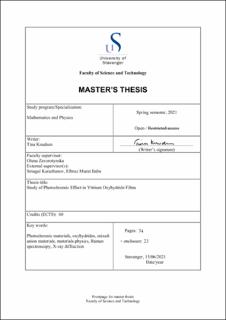| dc.description.abstract | Mixed anion compounds have multiple different anions as part of their structure. Due to the different nature of individual anions the mixed anion compounds may exhibit other properties than the well known single anion compounds (examples being oxides and hydrides). One group of the relatively new field of mixed anion compounds is the oxyhydrides. The oxyhydrides contain both H− and O2− anions. In this work yttrium oxyhydride (YHO), regarded as one of the rare-earth oxyhydrides (RE-O-H), was studied. This compound had already been observed to have interesting photochromic (PC) properties when illuminated by UV and visible light. A complete understanding on the origin of the PC effect and its limitations had although not yet been established.
The aim of this thesis was to study thin films of YHO on glass before and after UV- illumination to understand more of the color changing mechanism. Thin films of YHO deposited by reactive magnetron sputtering were studied by the methods of Raman spec- troscopy, X-ray diffraction (XRD) and cyclic optical testing. Some films coated with thin layers of palladium (Pd) were studied with regards to electrical resistivity as well. The latter was an attempt on revealing whether hydrogen diffusion takes part in the photodarkening. The electrical measurements were performed with a four point probe.
The thin films of YHO were observed to easily burn when exposed to lasers of wavelength 532 and 633 nm. From Raman measurements within the damaged spots on the film it was clear that the sample had been destroyed by the lasers. Thus, a large part of this work was related to optimizing the measurement conditions for Raman spectroscopy. The Raman peaks of the obtained spectra before and after UV exposure were assigned by literature study on similar compounds and factor group analysis (FGA).
The average grain size of the films was estimated by the Scherrer equation from the diffractograms obtained by XRD. Average grain size was shown to decrease with increasing deposition pressure. The experimental diffraction patterns were compared to reference patterns of yttrium hydrides and yttria in addition to theoretical patterns of different YHO structures. Raman and XRD showed possible hydrogen distortion after UV-illumination performed in Ar atmosphere and the possibility of multiple crystal structures present. | |
